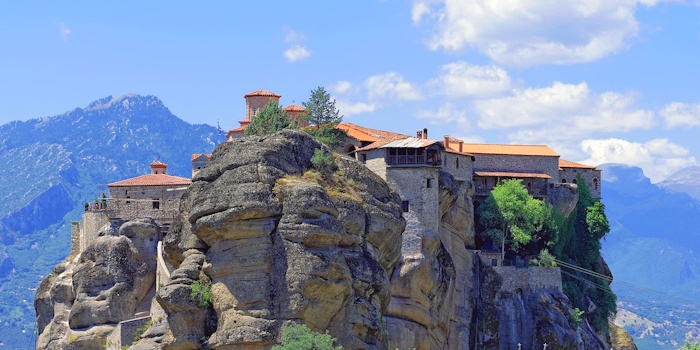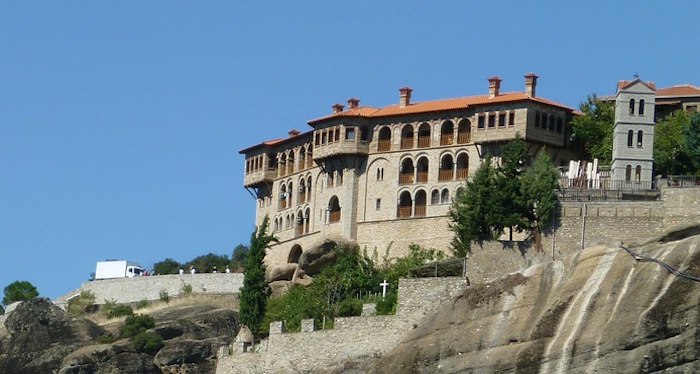What is Meteora?
Meteora is a breathtaking rocky landscape in central Greece, known for its gigantic, freestanding cliffs and the monasteries built upon them. The name Meteora comes from the Greek and means “suspended in the air,” referring to the impressive appearance of the rocks, some of which are up to 400 meters high.
Special Features:
Geology: The rocks of Meteora are made of sandstone and were formed about 60 million years ago by the erosion and retreat of an ancient sea. Over millennia, wind and rain have shaped the rocks into their present majestic forms.
Monasteries: Meteora is particularly known for the monastic communities that have existed there since the 14th century. Originally, a total of 24 monasteries were built on the rocks, but today only six active monasteries remain. These were used by monks and nuns who chose the remote location for spirituality and meditation.
What does Meteora mean?
Meteora (Greek: Μετέωρα) literally means “suspended in the air” or “floating in the skies.” The name refers to the impressive rock formations in the central region of Greece, which give the impression of floating in the air.
The ticket provider Getyourguide offers day tours from Athens and other cities to Meteora. They also offer overnight tours (two-day tours) and guided tours of Meteora. Tours from Athens combined with other attractions, such as Delphi, are also popular.

How to get to the top of the Meteora monasteries?
Cable cars (formerly used)
Historic cable cars: Cable cars were once used to reach the difficult-to-access monasteries. However, these are largely no longer in operation, and the monasteries are now only accessible by the methods mentioned above.
Today:
Some of the monasteries require a bit of an ascent on foot, especially the final section to reach the cave monasteries or monasteries on the highest cliffs.
The access routes have been well developed in recent years, but you should be prepared for the climb, especially if you plan to visit several monasteries.

Which Meteora Monasteries Should You Visit?
The Meteora monasteries are a fascinating destination, and there are several monasteries you can visit. Each has its own charm and a special history. Here are the most important monasteries you can visit during your visit to Meteora:
1. Great Meteoron (Megalo Meteoro)
Size: It is the largest and oldest monastery in Meteora.
History: Founded in the 14th century, it has a very long history. It was the first monastery built on one of the rocks.
Special Features: Inside, there are precious icons and religious artifacts. The views of the rocks and the surrounding area are spectacular from here.
Access: You have to climb a small staircase, but it is well-maintained and relatively easy to reach.
2. Varlaam Monastery
Size: The second largest monastery after the Great Meteoron.
History: Founded in the 14th century by local monks, it houses valuable frescoes and historical relics.
Special Features: It is particularly famous for its impressive views and interior frescoes.
Access: There is a bridge that leads you to the monastery and a steep staircase leading to the entrance. The view from here is also magnificent.
3. Rousanou Monastery
History: Originally a women’s monastery, it was founded in the 16th century. It was inhabited until the 1960s.
Special Features: This monastery is less visited than the larger ones and offers a quieter atmosphere. It is famous for its picturesque frescoes and beautiful scenery.
Access: From the parking lot, you have to climb a flight of stairs, but access is relatively easy.
4. Holy Trinity (Agia Triada)
History: Founded in the 14th century, this monastery is one of the oldest in the region.
Special features: It is located on one of the highest cliffs and offers magnificent views of the valley and the neighboring monasteries.
Access: The climb is steep, but worth it. Here you’ll also find many picturesque details and an impressive church.
5. St. Stephen’s Monastery (Agios Stefanos)
History: This monastery was founded in the 14th century but is the only one that is relatively easily accessible thanks to a bridge.
Special features: It houses impressive frescoes and one of the best views of the surrounding area. The monastery is now an active nunnery.
Access: There is a bridge that allows you to enter the monastery without having to climb steep stairs—making it the most accessible monastery in Meteora.
Recommended order of visits:
1.Great Meteoron and Varlaam: These two are the most famous and visited, so it’s best to visit early to avoid the crowds.
2.Rousanou and Holy Trinity: Both offer quieter yet equally impressive experiences.
3.St. Stephen’s Monastery: This monastery is a great place to end your tour because it’s very easily accessible.

How were the Meteora monasteries built?
The Meteora monasteries were built by monks in the 14th century on steep cliffs in Greece to find seclusion and protection. Construction was a major challenge: materials were transported to the high cliffs using cable cars, baskets, and crane systems. The monks built cells, chapels, and churches in the Byzantine style, using very simple and stable construction methods. The construction of a monastery could take decades. The remote location also provided protection from enemies and enabled the monks to live a spiritual and isolated lifestyle. Today, the monasteries are well preserved and an important tourist attraction.
How many Meteora monasteries are there?
Originally, there were 24 monasteries in the Meteora region. Today, however, only six active monasteries remain and are open to visitors. The others are either dilapidated or abandoned. These six monasteries are:
1.Great Meteoron
2.Varlaam
3.Holy Trinity (Agia Triada)
4.Rousanou
5.St. Stephen (Agios Stefanos)
6.St. Nicholas Anapausas (less well-known and smaller)
Where are the Meteora monasteries?
The Meteora monasteries are located in the region of Central Greece, near the town of Kalambaka, about 350 km north of Athens and 200 km south of Thessaloniki. They are built on high sandstone cliffs that rise dramatically above the surrounding valley. Meteora is located in the Thessaly region and is easily accessible from Kalambaka. This impressive rocky landscape is both a natural wonder and a historically significant religious center.
When were the Meteora monasteries built?
The Meteora monasteries were mainly built in the 14th century. The first monks began settling in the region in the late 11th century, but the majority of monasteries were established in the 14th century as religious and political pressure grew in Greece. The monasteries continued to expand until the 16th century. Construction of the monasteries often took several decades because access to the rocks was extremely difficult and the monks used primitive construction techniques.
Do the Meteora monasteries charge admission?
Yes, admission to the Meteora monasteries is free. Prices vary depending on the monastery and the season, but here is the general information:
Individual monasteries: Admission is typically €3 to €5 per monastery.
Combination ticket: You can purchase a combination ticket that includes admission to multiple monasteries. The combination ticket costs approximately €10 to €15 and is usually valid for three to four monasteries.
It is also important to note that some monasteries may offer free admission on certain days or during religious festivals.
What bus tours to the Meteora monasteries are available?
GetYourGuide offers various bus tours to the Meteora monasteries. Here are some examples:
1.Athens: 2-Day Tour to Meteora with 2 Guided Tours and Hotel Stay
Description: This tour includes a bus ride from Athens to Meteora, two guided tours (one in the morning and one at sunset), and an overnight stay in a hotel with breakfast.
Details: Visit all six monasteries with expert guides who will explain the history of the region.
Please note that availability and prices for these tours may vary. It is therefore advisable to check the latest information directly on the GetYourGuide website and book tours in advance.
2.From Athens to Meteora: Monasteries & Hidden Caves Bus Tour
Description: This tour begins with a bus ride from Athens to Kalambaka, followed by a guided visit to the Meteora monasteries and the Badovas Hermit Caves.
Details: Explore the history and architecture of the monasteries and enjoy panoramic views.
3.Meteora: Monasteries Tour, Lunch, and Athens Transfer Option
Description: This tour departs daily from the train station in Kalambaka and includes visits to the monasteries, an authentic Greek lunch, and the option to return to Athens.
Details: Explore the majestic monasteries and enjoy panoramic views.
4.Meteora Minibus Tour with Greek Lunch and Photo Stops
Description: A guided minibus tour from Kalambaka that includes visits to three monasteries, photo stops, and a traditional Greek lunch.
Details: Visit hidden gems such as the ancient Chapel of Doupiani and the Cave of St. George “Mandilas.”
Please note that availability and prices for these tours may vary. It is therefore advisable to check the latest information directly on the GetYourGuide website and book tours in advance.